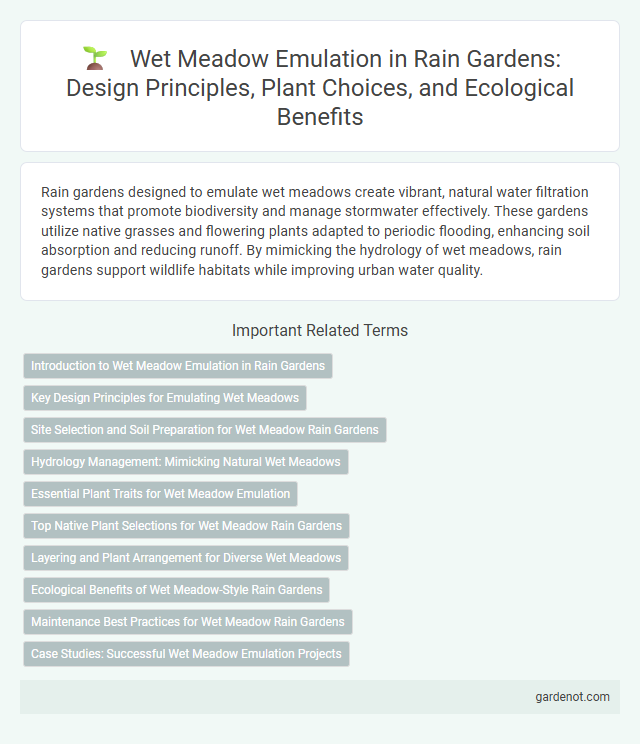Rain gardens designed to emulate wet meadows create vibrant, natural water filtration systems that promote biodiversity and manage stormwater effectively. These gardens utilize native grasses and flowering plants adapted to periodic flooding, enhancing soil absorption and reducing runoff. By mimicking the hydrology of wet meadows, rain gardens support wildlife habitats while improving urban water quality.
Introduction to Wet Meadow Emulation in Rain Gardens
Wet meadow emulation in rain gardens replicates the natural hydrology and vegetation of wet meadows to enhance stormwater management. This approach promotes native, moisture-tolerant plant species that support biodiversity while improving water infiltration and retention. By mimicking wet meadow ecosystems, rain gardens effectively reduce runoff, filter pollutants, and provide habitat for wetland wildlife.
Key Design Principles for Emulating Wet Meadows
Wet meadow emulation in rain garden design emphasizes hydrological variation by incorporating periodic inundation and dry phases to mimic natural wetland cycles. Native plant species with deep root systems are selected to enhance water filtration, soil stabilization, and habitat diversity. Incorporating gentle topographic relief promotes microhabitats and supports diverse flora and fauna while optimizing stormwater retention and groundwater recharge.
Site Selection and Soil Preparation for Wet Meadow Rain Gardens
Selecting a site for wet meadow rain gardens requires areas with moderate to low slope and proximity to natural water flow paths to facilitate consistent moisture levels. Soil preparation involves amending heavy clay soils with organic matter to improve drainage while retaining sufficient moisture, and ensuring soil pH ranges from 6.0 to 7.5 to support native wet meadow plant species. Proper site selection and tailored soil amendments optimize water infiltration and plant establishment, enhancing the ecological function of wet meadow rain gardens.
Hydrology Management: Mimicking Natural Wet Meadows
Wet meadow emulation in rain gardens optimizes hydrology management by replicating natural water absorption and slow release processes, enhancing groundwater recharge and reducing surface runoff. Strategically designed soil composition and native vegetation improve infiltration rates, promoting sustained moisture retention and minimizing erosion. This approach supports biodiversity while maintaining the hydrological balance characteristic of natural wet meadow ecosystems.
Essential Plant Traits for Wet Meadow Emulation
Essential plant traits for wet meadow emulation in rain gardens include high tolerance to periodic flooding and saturated soils, deep fibrous root systems for effective water absorption and soil stabilization, and the ability to support diverse pollinator species. Native grasses and flowering perennials with flexible stems reduce erosion while promoting nutrient cycling and habitat complexity. Selecting species with these adaptive traits enhances water retention and biodiversity, key features of functional wet meadow ecosystems.
Top Native Plant Selections for Wet Meadow Rain Gardens
Top native plant selections for wet meadow rain gardens include Carex stricta (tussock sedge), Juncus effusus (common rush), and Lobelia cardinalis (cardinal flower), which thrive in saturated soils and support local biodiversity. These species enhance water retention and filtration while providing essential habitat for pollinators and wetland wildlife. Incorporating a mix of grasses, sedges, and flowering perennials ensures seasonal interest and resilience in wet meadow rain garden designs.
Layering and Plant Arrangement for Diverse Wet Meadows
Layering and plant arrangement in wet meadow emulation are critical to creating a rain garden that supports biodiversity and effective water filtration. Incorporating a diverse mix of native grasses, sedges, and flowering perennials arranged in vertical and horizontal layers mimics natural wet meadow ecosystems, optimizing habitat complexity and soil stabilization. Strategic placement of deep-rooted species alongside shallow-rooted groundcovers enhances water infiltration and nutrient uptake, improving the rain garden's overall ecological function.
Ecological Benefits of Wet Meadow-Style Rain Gardens
Wet meadow-style rain gardens mimic natural floodplain ecosystems, enhancing biodiversity by providing habitat for pollinators, amphibians, and native wetland plants. These gardens improve water quality through natural filtration processes that reduce pollutants and sediment in stormwater runoff. Their deep-rooted vegetation stabilizes soil, mitigates erosion, and supports groundwater recharge, contributing to resilient urban landscapes.
Maintenance Best Practices for Wet Meadow Rain Gardens
Effective maintenance of wet meadow rain gardens involves regular monitoring of vegetation health and invasive species control to promote native plant diversity. Seasonal mowing or selective cutting helps manage plant height and prevents woody shrub encroachment, ensuring sustained water infiltration and habitat functionality. Nutrient management and periodic soil assessments support optimal wet meadow conditions, enhancing pollutant filtration and biodiversity benefits.
Case Studies: Successful Wet Meadow Emulation Projects
Successful wet meadow emulation projects demonstrate effective water retention and native plant restoration, enhancing urban biodiversity and stormwater management. Case studies such as the Lurie Garden in Chicago and the High Line in New York showcase strategic plant selection and soil engineering that replicate natural hydrology patterns. These projects highlight measurable improvements in habitat quality, flood mitigation, and community engagement through sustainable rain garden design.
Wet meadow emulation Infographic

 gardenot.com
gardenot.com